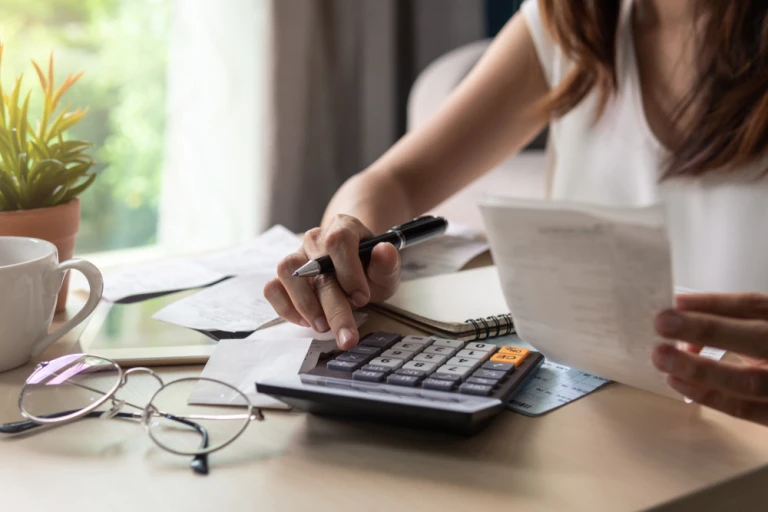How to complete a self-assessment tax return
HOME / / How to complete a self-assessment tax return
To complete a self-assessment tax return, you need to register for self-assessment, keep detailed financial records during the year, and complete a self-assessment tax return by the relevant deadline.
You'll need to complete a self-assessment tax return if you're self-employed and earn more than £1,000 from self-employment per year.
Read through the questions below to find out everything you need to know about filing your self-assessment tax return. But maybe get a coffee first...

What is a self-assessment tax return?
A self-assessment tax return is a form that self-employed people and certain business owners need to complete each year. It tells HMRC how much income tax you need to pay. It is called self-assessment because you’re responsible for providing the information HMRC need to calculate your tax.
Self-assessment doesn’t mean you need to complete it by yourself. You can use an accountant to help you with it. Alternatively, you can use accounting software to complete your tax return. Make sure it's approved by HMRC by checking this list of HMRC-approved self-assessment tax software.
Who has to complete a self-assessment tax return?
You have to complete a self-assessment tax return if you’re:
Self-employed as a sole trader, earning more than £1,000
A partner in a business partnership
The director of a limited company (subject to certain conditions)
Not sure what's the right business format for you? Check out our Guide to UK Company Formats and Business Structures.
How does self-assessment work?
Self-assessment isn’t quite as straightforward as you might think. It isn't simply calculating and paying what you owe for the past year. To really get to grips with it, it's worth looking at the Government advice page on understanding your self-assessment tax bill.
Basically, what you pay HMRC can comprise two different types of payment:
A balancing payment, which is any tax you owe from the previous tax year
Payment on account, which is the tax that HMRC predicts you’ll owe for the coming year. You have to pay this in two instalments, by 31st January and 31st July each year
When you complete your self-assessment tax return, HMRC will know exactly how much tax you should have paid for the previous year.
They’ll look at your ‘payments on account’ and see whether that covers your tax bill. If it covers your tax bill or exceeds it, you’ll receive a refund of the difference.
If it doesn’t cover your bill, you’ll receive a request for a ‘balancing payment’, which must be paid by 31st January the following year.
This means your tax bill for January each year comprises your first ‘payment on account’ for the forthcoming year, plus whatever you need to pay as a ‘balancing payment’ from the previous year.
Example of calculating a self-assessment tax payment
Here's an example of how self-assessment payments would look if you've earned more in the last tax year than expected.
You've already made payments on account last year of £900 each (£1,800 in total).
But this doesn't cover the full amount owed.
Your payment schedule for the forthcoming year will look like this:
[table id=21 /]
The £4,200 represents the shortfall in payments from last year, plus your predicted tax bill for the forthcoming year.
When do you have to complete a self-assessment tax return by?
There are a few deadlines to be aware of:
Register for self-assessment (if you haven’t submitted a self-assessment form before) – 5th October
File your tax return (paper form) - 31st October
File your tax return (online) – 31st January
Pay the tax you owe – 31st January
Pay your second ‘payment on account’ – 31st July
Which self-assessment tax form do I need to complete?
There are two self-assessment forms.
The short form – which is only a few pages long – and the full form, which is longer and more detailed.
Fill in the short form if your business's annual turnover is less than £85,000.
Fill in the full form if turnover was more than the VAT threshold or if you have a taxable income of over £100,000.
If you're unsure which return you should be filling out, call the HMRC self-assessment helpline on 0845 900 0444.
What information do I need to provide on my self-assessment tax return?
For the short form, you need to provide details of:
any employment you've had in the last tax year
details of self-employment and your business' financial records
allowable business expenses
net profit or loss
tax allowances for vehicles and equipment
Class 4 NICs and CIS deduction
any other income you have received (such as dividends, benefits, and so on)
For the full form, you'll also need details of:
any UK savings and investments
UK pensions, annuities and benefits
life insurance gains
AVC refunds
any other taxable income
Take a look at these Government fact sheets for more information:
Checklist
Follow these steps to prevent any problems with completing your self-assessment tax return
Work out which form you need to complete
Decide whether to file your return using a paper form or online (and note the two different deadlines)
Collect your financial records for the tax year that's just ended (starting and ending on 4th April), including your profit and loss account, business records and business expenses
Get together any relevant bank statements, dividend counterfoils, personal pension schemes and so on that you need
Get together any relevant forms such as P60, P45, P11D, PAYE notices of coding that you need
Stick to the deadlines to avoid getting fined for a late return or payment
What happens after I complete my self-assessment tax return?
If you fill out a paper return, HMRC will send you a letter telling you how much tax you owe and if you do it online it's calculated on-the-spot. Then comes the fun bit… paying your bill.
You can pay by debit card, by phone, cheque, post office, or online - you'll need your taxpayer reference number.

Self-assessment tax FAQs
You need to pay corporation tax. Find out more in this guide on how to calculate tax for a limited company.
Each partner needs to complete partnership pages as part of their individual tax return, but only one partner has to complete the partnership tax return. Find out more about the tax liability for partnerships.
Unfortunately, if you registered as self-employed, you still need to complete a return and send it off in time. The return shows you where to indicate whether you've made a net profit or loss.
HMRC advises you to use an estimate - a figure you want HM Revenue & Customs to accept as your final figure - or a provisional figure - one you want to use until you can confirm the actual amount (you must tell HMRC it is a provisional figure). But it's best to give them a call on 0845 900 0444 to check either way.
Your first stop would be to get in touch with the person who paid you for the work, but if that's not an option, call HMRC on 0845 900 0444 for advice, as there are different solutions for different situations.
As above, your first stop would be to get in touch with your former employer.

"We’re delighted to be the 2000th loan recipients!"
